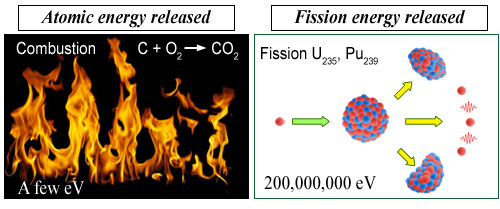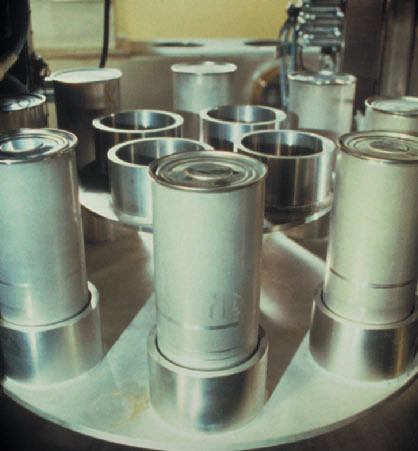A highly strategic material and a hazardous type of waste
What becomes of plutonium is central to the waste issue. Should plutonium be considered as an incredible energy resource or as highly radiotoxic waste?
In the 1960s and ’70s, American misgivings about reprocessing operations performed to extract plutonium from reactors were due to the risk of proliferation.
Plutonium extracted from civil reactors run under normal conditions cannot be used to make atom bombs. Weapons-grade plutonium, however, can be extracted from fuel that has spent a little time in a reactor. This was how North Korea managed to make an atom bomb with very limited resources. To limit the risk of proliferation, the United States has maintained the right to inspect the use of plutonium produced, as most reactors were built under U.S. licences.

A huge release of energy
When it undergoes nuclear fission, a plutonium nucleus releases about 20,000 times the energy released by the combustion of a carbon atom in the air. In terms of energy potential, it outclasses conventional sources of energy (coal, oil, gas) and “newcomers”, such as solar, wind and biomass, even more.
© IN2P3
Used for civil purposes, plutonium is absolutely packed with energy: a single gram of plutonium is the equivalent of a tonne of oil! Should we leave this resource untapped? On the other hand, plutonium is highly toxic if ingested. Before disposing of it once and for all as ultimate waste, we must ensure that there is no way to tap any more of its precious energy potential.
In the 1990s, it was planned for plutonium from French reactors to be burned as fuel in Superphenix, the first large fast breeder reactor. This was an effective way of consuming plutonium and stabilising its inventory, in other words the amount of plutonium that had accumulated.
Since Superphenix was shut down in 1997, France has opted for a midway solution. Plutonium from civil reactors, which is 70% fissile, is incorporated in uranium oxide to make fresh fuel and thus help generate more energy. This fuel is called MOX (for Mixed OXides). Twenty or so French reactors have been adapted to burn MOX.
This alternative is only moderately effective. When the reactor is loaded, some of the plutonium is replaced by fresh plutonium. In the end, the plutonium becomes polluted with non-fissile isotopes, which are not a very profitable energy source. Although tests have shown that a second recycling run is possible, it has been decided to put the fuel through the reactor only once and to store the spent MOX in pools, where it continues to accumulate. The increase in plutonium inventory has slowed down, but not stopped.

Plutonium cans for MOX fabrication
Plutonium from reprocessed spent fuel is recycled in France to make MOX, a new fuel containing uranium and plutonium. The photo shows the carrousel with plutonium cans used in the fabrication process at Areva’s Melox plant in Bagnols-sur-Cèze in the south of France.
© AREVA
MOX has an unexpected – and little-known – advantage: it can be of use in dismantling atomic bombs. There is nothing to prevent MOX from being made with weapons-grade plutonium, which contains more than 90% fissile plutonium-239. Burning this weapons-grade plutonium in a reactor will pollute it with non-fissile isotopes. Completely altered, it becomes useless for making bombs.
There are long-term prospects for reducing or stabilising the quantity of plutonium – or inventory – built up by reactors currently in operation. In theory, Generation IV reactors, distant descendants of Superphenix, would require the quantity of plutonium accumulated over 40 years’ operation of a PWR before they could be started up – around 2040! Thorium reactors could consume plutonium without producing any! And now for a little science fiction. In the distant future, will our descendants send these not enormous quantities of troublesome materials into the farthest reaches of outer space?
Other articles on the subject « The waste issue »
Waste or resource?
Spent fuel can still generate a lot of energy The fuel removed from a reactor core after three or[...]
Fuel Reprocessing
The spent fuel reprocessing option Spent fuel reprocessing is derived from a process called the P[...]
Alternative to reprocessing
Leave fuel as it is : do not reprocess If the spent fuel does not undergo reprocessing, the fuel [...]
Plutonium options
Plutonium: hazardous waste or miraculous raw material? For those who advocate pulling out of nucl[...]
Costs comparison
Reprocessing or not reprocessing: a comparison Which option for dealing with spent fuel from reac[...]